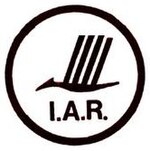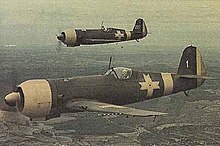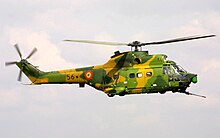Industria Aeronautică Română
 | |
| Industry | Aerospace |
|---|---|
| Founded | 1925 1968, re-established[1] |
| Headquarters | , Romania |
Key people | |
| Website | www |
Industria Aeronautică Română (IAR) (now IAR S.A. Brașov), or Romanian Aeronautic Industry in English, is a Romanian aerospace manufacturer.[2] It is based in Ghimbav, near Brașov, Romania.
IAR was founded in 1925 with the aid of the Romanian government, which sought to reduce reliance on foreign companies to supply the Royal Romanian Air Force with aircraft and associated equipment. In addition to its designs, the company built numerous foreign-designed aircraft under license as well. IAR produced a low-wing all-metal monoplane, the IAR 80, during the Second World War; this combat aircraft was extensively used by the nation during the conflict. During the Cold War era, the company branched out into helicopters, securing licensing agreements with France for their designs in the field, leading to the IAR 316 and IAR 330. In 2000, IAR partnered with the multinational helicopter manufacturer Eurocopter Group to create the Eurocopter Romania joint venture company. Presently, the company employs around 1,200 specialists including more than 170 engineers; it carries out upgrades, revisions, and overhauls on helicopters and light aircraft.[3]
History
Origins and early years

To ensure that the Royal Romanian Air Force (the Aeronautica Regală Română, or ARR) would be supplied with aircraft without reliance on foreign producers, the Romanian government subsidized the creation of three major aircraft manufacturers in the interbellum period. The first was Societatea pentru Exploatări Tehnice (SET) which was founded in Bucharest in 1923. Next came IAR, which was formed in Brașov since 1925. Finally there was Întreprinderea de Construcții Aeronautice Românești (ICAR), which was created in Bucharest in 1932, and operated a factory in Brașov known as ICA-Brașov (Întreprinderea de Construcții Aeronautice - Brașov).
One of the engineers designing IAR aircraft in the early 1930s was Elie Carafoli. During 1930, IAR's first original aircraft, the IAR CV 11, performed its maiden flight; it functioned as an experimental design only.[4] One of its earliest aircraft to reach quantity production was the IAR 14, a trainer aircraft derived from the IAR 12 prototype.[5] The IAR 27 was a more advanced trainer that was introduced in larger quantities during the late 1930s.[6]
In addition to pursuing its own designs, IAR also pursued work via the licensed production of foreign-developed aircraft. Poland's innovative PZL P.11 fighter captured the attention of Romanian officials, leading to a batch of 95 aircraft, referred to as the P.11f, being built by IAR starting in 1936.[7] The Romanian Air Force was greatly appreciative of the type, which heavily contributed to the decision to also licensed produce its upgraded derivative, the PZL P.24, which had been designed exclusively for the export market. Both models would see combat service during the Second World War.[8]
IAR worked throughout the conflict to produce large numbers of combat aircraft to equip the Romanian military. Perhaps one of the most significant aircraft to be produced by the company was built during these years in the form of the IAR 80, a low-wing monoplane all-metal monocoque fighter and ground-attack aircraft. When it first flew in 1939, the IAR 80 was claimed to be comparable to contemporary designs being deployed by the most advanced military powers, including the British Hawker Hurricane and the German Messerschmitt Bf 109E.[9] An improved model, the IAR 81 fighter aircraft, was designed and produced mid-way through the war as well.[2] The type remained in frontline use until May 1945, when the conflict was brought to an end.[10]
Cold War era
After World War II, starting from 1946, the production of IAR was oriented towards the manufacture of tractors. The first tractor produced being the IAR 22.[11][12]
Between 1945 and 1947, under the coordination of Radu Manicatide and Radu Mărdărescu, IAR developed a microcar, named M.R., and an automobile. However, the company did not persist with road vehicle development in the long term.[13] From 1947, IAR became the Intreprinderea Metalurgica de Stat (State Ironworks) and from 1948, the company was renamed to Uzina Tractorul Brașov (UTB).[11][12]

The current IAR was re-established in 1968 at Ghimbav, under the name Intreprinderea de Construcţii Aeronautice (ICA).[1] The ICA developed from the former Intreprinderea de Industrie Locală (IIL) glider manufacturer.[14] During this time, the company began to produce helicopters, motor gliders and airplanes, besides gliders. Romania arranged multiple licensing agreements with France, resulting in IAR producing Aérospatiale's SA 316B Alouette III under the local designation of IAR 316.[15] The company also manufactured a localised version of the Aérospatiale SA 330 Puma, designated IAR 330.[16] These rotorcraft were not only manufactured for domestic consumption, such as the Romanian Air Force, but also for the global market; roughly one-third of all IAR 330s were reportedly sold to export customers.[16][17] During the late 1980s, a Soviet-Romanian partnership led to the development of the Kamov Ka-126 helicopter; only a handful were built before production was terminated shortly following the Romanian Revolution and the collapse of the Communist government.[18]
Since 1968, IAR has produced more than 360 helicopters, along with 830 gliders and including motor gliders, as well as 136 light aircraft.[1]
Twenty-first century
During the late 1990s, American aerospace company Bell Helicopters entered negotiations on the topic of acquiring a majority stake in IAR.[19] According to aerospace periodical Flight International, Bell was at one stage set to purchase a 70 percent shareholding in the firm; this arrangement was closely tied to a planned procurement of the AH-1RO Dracula attack helicopter by Romania, which would have been manufactured locally by IAR.[20] However, by 1998, the purchase was put on hold while efforts were made to raise funds for the AH-1RO purchase.[21][22] Following a period of negotiations, in November 1999, Bell announced that it had abandoned its intentions to take over IAR and to locally produce the AH-1RO.[23]
During 2000, it was announced that the multinational helicopter manufacturer Eurocopter Group was holding discussions over its own bid for IAR.[24] Later that same year, IAR established Eurocopter Romania in conjunction with Eurocopter, the former held a 49% stake in the newly created joint venture.[25][26] In November 2015, Airbus Helicopters announced plans to invest €52 million in a Romanian facility to manufacture the 8.6t H215M Super Puma; this arrangement was reportedly reliant upon an initial order for 16 being placed by the Romanian government to extend the type's production.[27][28]
Products






| Model name | First flight | Number built | Type |
|---|---|---|---|
| IAR CV 11 | 1930 | 1 | Single engine monoplane fighter |
| IAR 12 | 1933 | 1[29] | Single engine monoplane fighter |
| IAR 13 | 1933 | 1 | Single engine monoplane fighter |
| IAR 14 | 1933 | 21[30] | Single engine monoplane fighter |
| IAR 15 | 1933 | 5 | Single engine monoplane fighter |
| IAR 16 | 1934 | 1 | Single engine monoplane fighter |
| IAR 21 | 1 | Single engine monoplane trainer[31] | |
| IAR 22 | 2[32] | Single engine monoplane trainer | |
| IAR 23 | 1 | Single engine monoplane touring airplane[33] | |
| IAR 24 | 1 | Single engine monoplane touring airplane[34] | |
| IAR 27 | 1937 | 200+ | Single engine monoplane trainer |
| IAR 37 | 1937 | 50 | Single engine biplane light bomber |
| IAR 38 | 1937 | 75 | Single engine biplane light bomber |
| IAR 39 | 1937 | 95[a] | Single engine biplane light bomber |
| IAR 47 | 1942 | 2 | Single engine monoplane light bomber |
| IAR 79 | 1937 | 72 | Twin engine monoplane bomber |
| IAR 80 | 1939 | 250[35] | Single engine monoplane fighter |
| IAR 81 | 1939 | 200[35] | Single engine monoplane fighter/dive bomber |
| IAR 471 | N/A | 1 | Single engine monoplane dive bomber |
| License Built Aircraft | |||
| Morane-Saulnier MS.35 | 30[36] | License built single engine monoplane trainer | |
| Potez 25 | 217[37] | License built single engine biplane light bomber[38] | |
| IAR P.11F | 95 | License built single engine monoplane fighter | |
| IAR P.24E | 25 | License built single engine monoplane fighter | |
| Fleet 10G | 95[39] | License built single engine biplane trainer | |
| Savoia-Marchetti SM.62 | 5[40] | License built single engine monoplane flying boat patrol airplane | |
| Assembled | |||
| Messerschmitt Bf 109G | 1943 | 124[b] | Single engine monoplane fighter |
| Postwar | |||
| IAR 811 | 1949 | 1 | Single engine monoplane trainer |
| IAR 813 | 1950 | 80 | Single engine monoplane trainer |
| IAR 814 | 1953 | 10 | Twin engine monoplane transport |
| IAR 817 | 1955 | 60+ | Single engine monoplane utility airplane |
| IAR 818 | 1960 | Single engine monoplane utility airplane | |
| IAR 821 | 1967 | 21 | Single engine monoplane agricultural airplane |
| IAR 822 | 1970 | 30 | Single engine monoplane agricultural airplane |
| IAR 823 | 1973 | 80 | Single engine monoplane trainer |
| IAR 824 | 1971 | 10 | Single engine monoplane utility airplane |
| IAR 825 Triumf | 1982 | 1 | Single engine monoplane trainer |
| IAR 826 | 1973 | 13 | Single engine monoplane agricultural airplane |
| IAR 827 | 1976 | 17 | Single engine monoplane agricultural airplane |
| IAR 831 | 1983 | 1 | Single engine monoplane trainer |
| IAR 46 | 1993 | Single engine monoplane touring airplane | |
| Helicopters | |||
| IAR 316 Alouette III | 250 | Single engine utility helicopter | |
| IAR 317 Airfox | 1 | Single engine attack helicopter | |
| IAR 330 Puma | 1975 | >163 | Twin engine utility helicopter |
| Kamov Ka-126 | 1988 | 17 | Single engine utility helicopter |
| Gliders | |||
| ICA IS-3 | Glider | ||
| ICA IS-4 | 1959 | Glider | |
| ICA IS-8 | 1960 | Glider | |
| ICA IS-10 | 1960 | Glider | |
| ICA IS-11 | 1959 | Glider | |
| ICA IS-12 | 1960 | 1 | Glider |
| ICA IS-13 | 1960 | 1 | Glider |
| ICA IS-23 | 1968 | Single engine utility airplane | |
| ICA IS-28 | 1970 | Glider | |
| ICA IS-28M | Motorglider | ||
| ICA IS-29 | 1970 | Glider | |
| ICA IS-30 | Glider | ||
| ICA IS-31 | Glider | ||
| ICA IS-32 | 1977 | Glider | |
| ICA IS-33 | Glider | ||
| ICA IAR-35 | 1986 | 4+ | Glider |
See also
References
Footnotes
References
- ^ a b c "General Information". IAR. Retrieved 28 March 2022.
- ^ a b "Industria Aeronautica Romana IAR 80 & 81". Century of Flight. Archived from the original on 12 November 2016. Retrieved 28 March 2022.
- ^ "Romania: Aviation Industry". Country Data. July 1989. Retrieved 28 March 2022.
- ^ Grey, C.G., ed. (1931). Jane's all the World's Aircraft 1931. London: Sampson Low, Marston & company, ltd. p. 226c.
- ^ Grey, C.G.; Bridgman, Leonard, eds. (1938). Jane's all the World's Aircraft 1938. London: Sampson Low, Marston & company, ltd. p. 230c.
- ^ The Illustrated Encyclopedia of Aircraft (Part Work 1982-1985). Orbis Publishing. 1985. p. 2180.
- ^ Morgała 1997, p. 63.
- ^ Cynk 1967, p. 7.
- ^ Murphy, Justin D.; McNiece, Matthew A. (2008). Military Aircraft, 1919–1945: An Illustrated History of Their Impact. Weapons and Warfare (First ed.). Santa Barbara, California: ABC-CLIO. ISBN 9781851094981. Retrieved 30 August 2017.
- ^ Antoniu and Cicos 2000, pp. 239–248.
- ^ a b "UTB Company history". Archived from the original on 2 April 2004. Retrieved 20 October 2021.
- ^ a b "Tractorul". Automobile Romanesti. Archived from the original on 9 September 2022. Retrieved 28 March 2022.
- ^ "Din Istoria Automobilului" [From the History of the Automobile] (in Romanian). Retrieved 28 March 2022.
- ^ Gudju, Iacobescu & Ionescu 1974, p. 48.
- ^ "World Air Forces 2013" (PDF). Flightglobal Insight. 2013. Retrieved 28 February 2013.
- ^ a b Marnix Sap, Carlo Brummer: Fortele Aeriene Romane in: Lotnictwo Nr. 4/2010, pp. 40–41 (in Polish)
- ^ "IISS Military Balance 2010". Archived from the original on 2013-01-19. Retrieved 2020-05-07.
- ^ Lambert, Mark. Jane's All The World's Aircraft 1993–94. Coulsdon, UK: Jane's Data Division, 1993. pp. 277–278. ISBN 0-7106-1066-1.
- ^ "Bell chimes". Flight International. 5 September 1996.
- ^ "Bell signs up for majority stake in Romania's IAR". Flight International. 28 May 1997.
- ^ "Romania offers to revive Dracula". Flight International. 28 January 1998.
- ^ Derby, Paul (11 September 1998). "Talks set to thrash out IAR-Bell details". Flight International.
- ^ "Bell drives stake through heart of Romanian deal". Flight International. 17 November 1999.
- ^ "Eurocopter postpones bid for Romanian IAR". Flight International. 2 May 2000.
- ^ "Signature marks to the Go Ahead For Eurocopter Romania" Archived 15 March 2012 at the Wayback Machine Eurocopter. Eurocopter.com. Accessed 9 July 2011.
- ^ "EC ROMANIA (EUROCOPTER ROMANIA SA)" Archived 18 September 2011 at the Wayback Machine Eurocopter. Eurocopter.com. Accessed 9 July 2011.
- ^ Murdo Morrison (11 Jan 2018). "Airbus's big plan to revive the Romanian rotorcraft sector". Flight International.
- ^ "Romania to host production of new, robust, and cost-effective H215 heavy helicopter." Airbus Helicopters, 17 November 2015.
- ^ Antoniu 2014, p. 122.
- ^ Antoniu 2014, p. 124.
- ^ Gudju, Iacobescu & Ionescu 1974, p. 148.
- ^ Antoniu 2014, p. 127.
- ^ Gudju, Iacobescu & Ionescu 1974, p. 160.
- ^ Gudju, Iacobescu & Ionescu 1974, p. 178.
- ^ a b Antoniu 2014, pp. 156–159.
- ^ Gudju, Iacobescu & Ionescu 1974, p. 110.
- ^ Antoniu 2014, p. 90.
- ^ Gudju, Iacobescu & Ionescu 1974, p. 114.
- ^ Antoniu, Dan; Cicos, George (2007). Romanian Aeronautical Constructions (2nd ed.). Bucharest: Vivaldi. pp. 197–198. ISBN 978-973-150-002-7.
- ^ Anthony Robinson (1979). The Illustrated encyclopedia of aviation, Volume 11. Marshall Cavendish Corp. p. 11. ISBN 9780856853180.
- ^ Dan Antoniu (23 April 2017). "O enigmă elucidată". art-emis (in Romanian).
Bibliography
- Dan, Antoniu; Cicos, George (2000). Vanatorul IAR-80 – istoria unui erou necunoscut [IAR-80 Fighter: The History of An Unknown Hero] (in Romanian). Bucharest, Romania: Editura Modelism International Ltd.
- Cynk, Jerzy B. (1967). The P.Z.L. P-24. Aircraft in Profile. Leatherhead, Surrey, UK: Profile Publications Ltd.
- Morgała, Andrzej (1997). Samoloty wojskowe w Polsce 1918-1924 [Military aircraft in Poland 1918-1924] (in Polish). Warsaw: Lampart. ISBN 83-86776-34-X.
- Gudju, Ion; Iacobescu, Gheorghe; Ionescu, Ovidiu (1974). Romanian Aeronautical Constructions, 1905–1974 (PDF). Bucharest: Military Publishing House. Retrieved 28 March 2022.
- Antoniu, Dan (2014). Illustrated History of Romanian Aeronautics. Bucharest. ISBN 978-973-0-17209-6.
{cite book}: CS1 maint: location missing publisher (link)